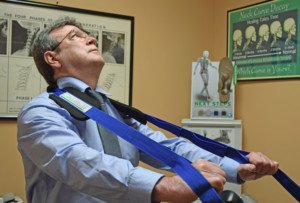
You’re not imagining it: Pushups really do work your abs.
Think about what actually happens when you do pushups:
Your abdominal region is the link between stabilizing your upper body and your lower body as you perform this multi-joint exercise.
When I was a personal trainer, I’d tell people that pushups work the chest, triceps, shoulders AND core – which includes the abs.
If you have a weak core, you will struggle with pushups – which are close relatives of the famed plank.
“Pushups are actually similar to performing planks when it comes to engaging the core abdominal muscles,” says Dr. Tom Carpenter, corrective exercise specialist, certified personal trainer and chiropractor, inventor of Stand Corrected™, a portable harness-like stretching tool that helps alleviate back, neck and shoulder pain.
“In my opinion, planks are one of the best exercises for strengthening the abs.” Think of a pushup as a plank with arms.
What makes the abs work during a pushup?
One of the muscle groups that helps stabilize the spine is the abs. When you do pushups, the spine is under tension, and something needs to keep it stabilized or else it will collapse or cave in.
This familiar collapsing or caving in is often seen in people struggling to do pushups.
The middle of your body plays a key role in keeping it straight like a ruler while doing pushups.

Shutterstock/sanneberg
You may have the strongest chest and arms in the world – but a weak core will make good pushup form difficult.
Are pushups the best way to work the abs?
The answer is no, but the engagement of the abdominal region during this compound movement is a nice added benefit.
Will hammering out sit-ups and leg lifts give a person with a weak upper body the ability to do pushups? No.
A strength training program that focuses on compound moves will generate the ability to perform textbook-form pushups.
The program should include “pushing” exercises such as the following:
• Flat bench press
• Slightly angled bench press
• Incline shoulder press with barbell or dumbbells
• Supine (lying on back) dumbbell press
• Seated chest press with machines
• Standing overhead press with barbell or dumbbells
• Standing overhead press with a heavy ball
• Seated dip
And of course, the rest of the regimen should include back and leg work, e.g., deadlift, squat, leg press, bent-over dumbbell row.
A mistake that many people make is that of diving into pushups while they still have a weak upper body.
You can acquire the strength to do pushups without actually doing them, if you work hard and intensely doing the moves mentioned above.
When you feel ready to give pushups a try, go ahead, but work on textbook form first, rather than gunning for many reps.
Use your knees if you must as a stepping stone to the military style movement.
Two repetitions with perfect form are better than 10 sloppy ones.
If you feel your abs working during pushups, you are doing something RIGHT!

Photo credit: Aleesia Forni











